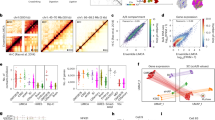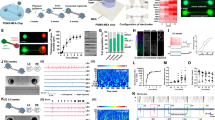Abstract
Brain function relies on communication between large populations of neurons across multiple brain areas, a full understanding of which would require knowledge of the time-varying activity of all neurons in the central nervous system. Here we use light-sheet microscopy to record activity, reported through the genetically encoded calcium indicator GCaMP5G, from the entire volume of the brain of the larval zebrafish in vivo at 0.8 Hz, capturing more than 80% of all neurons at single-cell resolution. Demonstrating how this technique can be used to reveal functionally defined circuits across the brain, we identify two populations of neurons with correlated activity patterns. One circuit consists of hindbrain neurons functionally coupled to spinal cord neuropil. The other consists of an anatomically symmetric population in the anterior hindbrain, with activity in the left and right halves oscillating in antiphase, on a timescale of 20 s, and coupled to equally slow oscillations in the inferior olive.
This is a preview of subscription content, access via your institution
Access options
Subscribe to this journal
Receive 12 print issues and online access
$259.00 per year
only $21.58 per issue
Buy this article
- Purchase on Springer Link
- Instant access to full article PDF
Prices may be subject to local taxes which are calculated during checkout






Similar content being viewed by others
Change history
05 April 2013
The authors note that Michael B. Orger, Drew N. Robson and Jennifer M. Li should be added to the author list of the version of this article initially published online. This change affects the author list, affiliations, Acknowledgments and Author Contributions. The error has been corrected for the print, PDF and HTML versions of this article.
References
Averbeck, B.B., Latham, P.E. & Pouget, A. Neural correlations, population coding and computation. Nat. Rev. Neurosci. 7, 358–366 (2006).
Friedrich, R.W., Habermann, C.J. & Laurent, G. Multiplexing using synchrony in the zebrafish olfactory bulb. Nat. Neurosci. 7, 862–871 (2004).
Schneidman, E., Berry, M.J. II, Segev, R. & Bialek, W. Weak pairwise correlations imply strongly correlated network states in a neural population. Nature 440, 1007–1012 (2006).
Stopfer, M., Jayaraman, V. & Laurent, G. Intensity versus identity coding in an olfactory system. Neuron 39, 991–1004 (2003).
Druckmann, S. & Chklovskii, D.B. Neuronal circuits underlying persistent representations despite time varying activity. Curr. Biol. 22, 2095–2103 (2012).
Gregoriou, G.G., Gotts, S.J. & Desimone, R. Cell-type-specific synchronization of neural activity in FEF with V4 during attention. Neuron 73, 581–594 (2012).
Churchland, M.M. et al. Neural population dynamics during reaching. Nature 487, 51–56 (2012).
Deco, G., Jirsa, V.K. & McIntosh, A.R. Emerging concepts for the dynamical organization of resting-state activity in the brain. Nat. Rev. Neurosci. 12, 43–56 (2011).
Ahrens, M.B. et al. Brain-wide neuronal dynamics during motor adaptation in zebrafish. Nature 485, 471–477 (2012).
Flusberg, B.A. et al. High-speed, miniaturized fluorescence microscopy in freely moving mice. Nat. Methods 5, 935–938 (2008).
Katona, G. et al. Fast two-photon in vivo imaging with three-dimensional random-access scanning in large tissue volumes. Nat. Methods 9, 201–208 (2012).
Holekamp, T.F., Turaga, D. & Holy, T.E. Fast three-dimensional fluorescence imaging of activity in neural populations by objective-coupled planar illumination microscopy. Neuron 57, 661–672 (2008).
Grewe, B.F., Langer, D., Kasper, H., Kampa, B.M. & Helmchen, F. High-speed in vivo calcium imaging reveals neuronal network activity with near-millisecond precision. Nat. Methods 7, 399–405 (2010).
Cheng, A., Goncalves, J.T., Golshani, P., Arisaka, K. & Portera-Cailliau, C. Simultaneous two-photon calcium imaging at different depths with spatiotemporal multiplexing. Nat. Methods 8, 139–142 (2011).
Marre, O. et al. Mapping a complete neural population in the retina. J. Neurosci. 32, 14859–14873 (2012).
Akerboom, J. et al. Optimization of a GCaMP calcium indicator for neural activity imaging. J. Neurosci. 32, 13819–13840 (2012).
Park, H.C. et al. Analysis of upstream elements in the HuC promoter leads to the establishment of transgenic zebrafish with fluorescent neurons. Dev. Biol. 227, 279–293 (2000).
Naumann, E.A., Kampff, A.R., Prober, D.A., Schier, A.F. & Engert, F. Monitoring neural activity with bioluminescence during natural behavior. Nat. Neurosci. 13, 513–520 (2010).
Tomer, R., Khairy, K., Amat, F. & Keller, P.J. Quantitative high-speed imaging of entire developing embryos with simultaneous multiview light-sheet microscopy. Nat. Methods 9, 755–763 (2012).
Keller, P.J., Schmidt, A.D., Wittbrodt, J. & Stelzer, E.H.K. Reconstruction of zebrafish early embryonic development by scanned light sheet microscopy. Science 322, 1065–1069 (2008).
Sumbre, G., Muto, A., Baier, H. & Poo, M.M. Entrained rhythmic activities of neuronal ensembles as perceptual memory of time interval. Nature 456, 102–106 (2008).
Kinkhabwala, A. et al. A structural and functional ground plan for neurons in the hindbrain of zebrafish. Proc. Natl. Acad. Sci. USA 108, 1164–1169 (2011).
Koyama, M., Kinkhabwala, A., Satou, C., Higashijima, S. & Fetcho, J. Mapping a sensory-motor network onto a structural and functional ground plan in the hindbrain. Proc. Natl. Acad. Sci. USA 108, 1170–1175 (2011).
Leopold, D.A., Murayama, Y. & Logothetis, N.K. Very slow activity fluctuations in monkey visual cortex: implications for functional brain imaging. Cereb. Cortex 13, 422–433 (2003).
Junek, S., Chen, T.W., Alevra, M. & Schild, D. Activity correlation imaging: visualizing function and structure of neuronal populations. Biophys. J. 96, 3801–3809 (2009).
Hatta, K. & Korn, H. Tonic inhibition alternates in paired neurons that set direction of fish escape reaction. Proc. Natl. Acad. Sci. USA 96, 12090–12095 (1999).
Orger, M.B., Kampff, A.R., Severi, K.E., Bollmann, J.H. & Engert, F. Control of visually guided behavior by distinct populations of spinal projection neurons. Nat. Neurosci. 11, 327–333 (2008).
Miri, A. et al. Spatial gradients and multidimensional dynamics in a neural integrator circuit. Nat. Neurosci. 14, 1150–1159 (2011).
Chorev, E., Yarom, Y. & Lampl, I. Rhythmic episodes of subthreshold membrane potential oscillations in the rat inferior olive nuclei in vivo. J. Neurosci. 27, 5043–5052 (2007).
Nikolaou, N. et al. Parametric functional maps of visual inputs to the tectum. Neuron 76, 317–324 (2012).
Del Bene, F. et al. Filtering of visual information in the tectum by an identified neural circuit. Science 330, 669–673 (2010).
Blumhagen, F. et al. Neuronal filtering of multiplexed odour representations. Nature 479, 493–498 (2011).
Aizenberg, M. & Schuman, E.M. Cerebellar-dependent learning in larval zebrafish. J. Neurosci. 31, 8708–8712 (2011).
Douglass, A.D., Kraves, S., Deisseroth, K., Schier, A.F. & Engert, F. Escape behavior elicited by single, channelrhodopsin-2-evoked spikes in zebrafish somatosensory neurons. Curr. Biol. 18, 1133–1137 (2008).
Paninski, L. et al. A new look at state-space models for neural data. J. Comput. Neurosci. 29, 107–126 (2010).
Yu, B.M. et al. Gaussian-process factor analysis for low-dimensional single-trial analysis of neural population activity. J. Neurophysiol. 102, 614–635 (2009).
Acknowledgements
We thank M. Coleman (Coleman Technologies) for custom microscope operating software; Janelia Farm Research Campus Instrument Design and Fabrication for custom mechanical parts; Janelia Farm Research Campus Vivarium staff for animal care; C. Riegler (Harvard) for crossing the elavl3:GCaMP5G fish line into the albino background; R. Tomer, L. Lagnado and L. Looger for their contributions to early GCaMP test experiments using light-sheet microscopy; K. Branson, V. Jayaraman, L. Looger, K. Svoboda, F. Amat, W. Lemon and M. Yartsev for helpful discussions and critical reading of the manuscript; A. Schier (under US National Institutes of Health (NIH) grants R01HL109525 and R01GM085357) and F. Engert (under NIH grant DP1NS082121) for supporting the work of D.N.R. and J.M.L.; and A. Kampff (Harvard) for providing M.B.O. with access to a custom two-photon microscope. This work was supported by the Howard Hughes Medical Institute.
Author information
Authors and Affiliations
Contributions
M.B.A. and P.J.K. conceived of the research, performed the experiments, analyzed the data and wrote the paper. D.N.R., J.M.L. and M.B.O. generated the elavl3:GCaMP5G fish line. M.B.O. acquired the two-photon cell-counting image stack and participated in preliminary experiments.
Corresponding authors
Ethics declarations
Competing interests
The authors declare no competing financial interests.
Supplementary information
Supplementary Text and Figures
Supplementary Figures 1–5, Supplementary Table 1 and Supplementary Notes 1 and 2 (PDF 5060 kb)
Supplementary Software
Image processing and analysis of whole-brain functional recordings (ZIP 350 kb)
Fast volumetric imaging of the zebrafish brain with light-sheet microscopy
Slicing series of the 800 × 600 × 200 μm3 volume of an elavl3:GCaMP5G-labeled larval zebrafish brain, recorded in 5-μm steps with a 4.25 ± 0.80–μm–thick light sheet (full width at half maximum mean ± s.d. across the brain volume, n = 81). The video playback rate of 30 frames per second is equivalent to the acquisition rate in the microscope. The entire brain volume was recorded at a rate of 0.8 Hz. To reduce the size of this video, we downsampled microscopy images by a factor of 4. Detection objective: Nikon CFI75 LWD 16×/0.80 W. (AVI 4248 kb)
Selected slices from a zebrafish whole-brain light-sheet microscopy recording
Set of 10 out of 41 slices from a volumetric light-sheet recording of an elavl3:GCaMP5G-labeled larval zebrafish brain, showing functional activity recorded at different depths of the 600 × 800 × 200 μm3 volume. The video shows raw microscopy data prior to image registration. To reduce the size of this video, we downsampled microscopy images by a factor of 20. Detection objective: Nikon CFI75 LWD 16×/0.80 W. (AVI 15524 kb)
Whole-brain imaging of neuronal activity (visualization A, slices)
Whole-brain, neuron-level functional activity in a complete set of slices from a volumetric light-sheet recording of an elavl3:GCaMP5G-labeled larval zebrafish brain, superimposed on the reference anatomy (gray). Supplementary Videos 2–6 show different visualizations of the same whole-brain recording. To reduce the size, we downsampled microscopy images by a factor of 64. Detection objective: Nikon CFI75 LWD 16×/0.80 W. (AVI 20114 kb)
Whole-brain imaging of neuronal activity (visualization B, projections)
Dorsal, lateral and frontal maximum-intensity projections of whole-brain, neuron-level functional activity, reported by the genetically encoded calcium indicator GCaMP5G in an elavl3:GCaMP5G fish, superimposed on maximum-intensity projections of the reference anatomy (gray). Supplementary Videos 2–6 show different visualizations of the same whole-brain recording. To reduce the size, we downsampled microscopy images by a factor of 4. Detection objective: Nikon CFI75 LWD 16×/0.80 W. (AVI 20138 kb)
Whole-brain imaging of neuronal activity (visualization C, raw ΔF/F)
Left, dorsal maximum-intensity projections of whole-brain, neuron-level functional activity, reported by the genetically encoded calcium indicator GCaMP5G in an elavl3:GCaMP5G fish, superimposed on maximum-intensity projections of the reference anatomy (gray). Right, functional activity only. Supplementary Videos 2–6 show different visualizations of the same whole-brain recording. To reduce the size, we downsampled microscopy images by a factor of 4. Detection objective: Nikon CFI75 LWD 16×/0.80 W. (AVI 19565 kb)
Neuronal activity in the forebrain
Dorsal maximum-intensity projections of neuron-level functional activity in the forebrain, reported by the genetically encoded calcium indicator GCaMP5G in an elavl3:GCaMP5G fish, superimposed on maximum-intensity projections of the reference anatomy (gray). This video shows full-resolution images for the forebrain region of the whole-brain recording visualized in Supplementary Video 5. Supplementary Videos 2–6 show different visualizations of the same whole-brain recording. Detection objective: Nikon CFI75 LWD 16×/0.80 W. (AVI 22405 kb)
Three-dimensional visualization of the hindbrain oscillator (fish from Fig. 6)
Rotating maximum-intensity projection of the three-dimensional data set underlying Figure 6a. (AVI 5743 kb)
Three-dimensional visualization of hindbrain-spinal circuit (fish from Fig. 6)
Rotating maximum-intensity projection of the three-dimensional data set underlying Figure 6f. (AVI 6142 kb)
Three-dimensional visualization of the hindbrain oscillator (fish from Supplementary Fig. 3e)
Rotating maximum-intensity projection of the three-dimensional data set underlying Supplementary Fig. 3e. (AVI 5796 kb)
Rights and permissions
About this article
Cite this article
Ahrens, M., Orger, M., Robson, D. et al. Whole-brain functional imaging at cellular resolution using light-sheet microscopy. Nat Methods 10, 413–420 (2013). https://doi.org/10.1038/nmeth.2434
Received:
Accepted:
Published:
Issue Date:
DOI: https://doi.org/10.1038/nmeth.2434
This article is cited by
-
High-resolution tracking of unconfined zebrafish behavior reveals stimulatory and anxiolytic effects of psilocybin
Molecular Psychiatry (2024)
-
Current and future applications of light-sheet imaging for identifying molecular and developmental processes in autism spectrum disorders
Molecular Psychiatry (2024)
-
Blazed oblique plane microscopy reveals scale-invariant inference of brain-wide population activity
Nature Communications (2023)
-
An optofluidic platform for interrogating chemosensory behavior and brainwide neural representation in larval zebrafish
Nature Communications (2023)
-
Imagining the future of optical microscopy: everything, everywhere, all at once
Communications Biology (2023)



